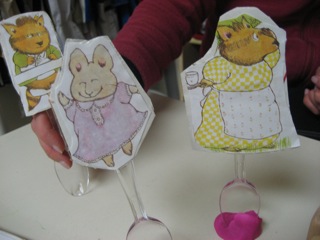 What are “Spoon People” you ask? After over 35 years doing speech and language therapy, it is fun to invent something new that really works with kids.
What are “Spoon People” you ask? After over 35 years doing speech and language therapy, it is fun to invent something new that really works with kids.
I was trying to think of a way to interest one of my kids on the autism spectrum to re-tell a story. He just recently has become interested in picture books (only if they are the right combination of fun, simple, short, and inviting). I usually have two books in our repertoire, one that is very familiar that we have read and re-told in new ways, asked questions about and done a little predicting, and one that is new to him. Once i get him engaged in the fun and familiar book, I quickly move into the second one before too much protest. Soon the second book becomes the familiar one and so on.
Well now we are moving to re-telling the story. How can we do that in a fun way? I copied pictures of the characters in Timothy Goes to School by Rosemary Wells. I took Timothy, Claude, Timothy’s mom and Violet as my main characters. I glued them to a sturdy cardboard backing and in my search for a stable stick to hold them, I came upon a plastic spoon—and my spoon people were born!
First we took the spoon people and re-told the story. Then we moved to flexibly changing the story. My little friend didn’t like that Claude was mean to Timothy and quickly changed him to a “friend” and invited him over for cookies after school.
Next, I used the spoon people for practice in description. We take turns picking a character and keeping its identity secret while the other person guesses his identity from our clues. My little client held Timothy and said, “He’s nice.” “He is wearing a new shirt.” “He goes home with Violet.”
Spoon people have been known to go on to enter pretend play with a child’s favorite animals to animate. We got out the blocks and Timothy and Violet went to the aquarium with the sharks. Kids love the spoon people because they get attached to and familiar with the characters. They don’t want to leave them behind in a book!

